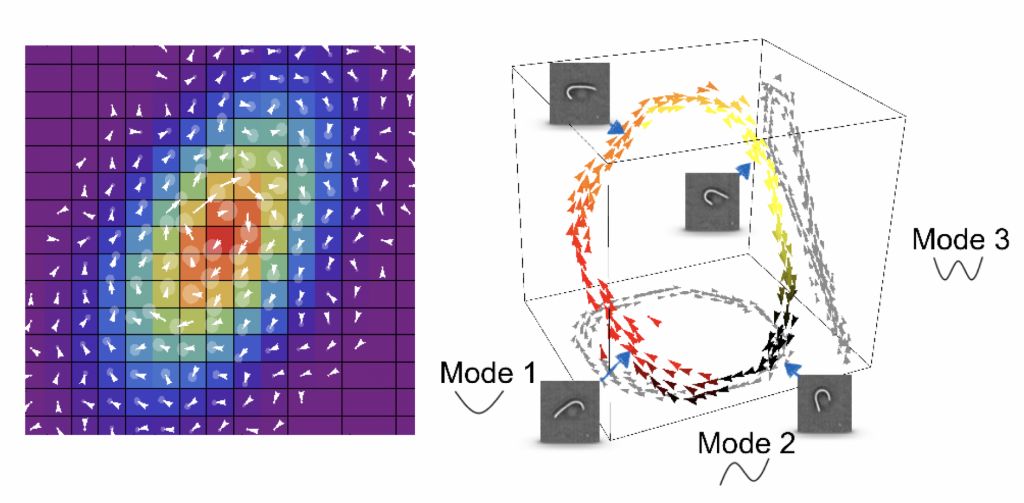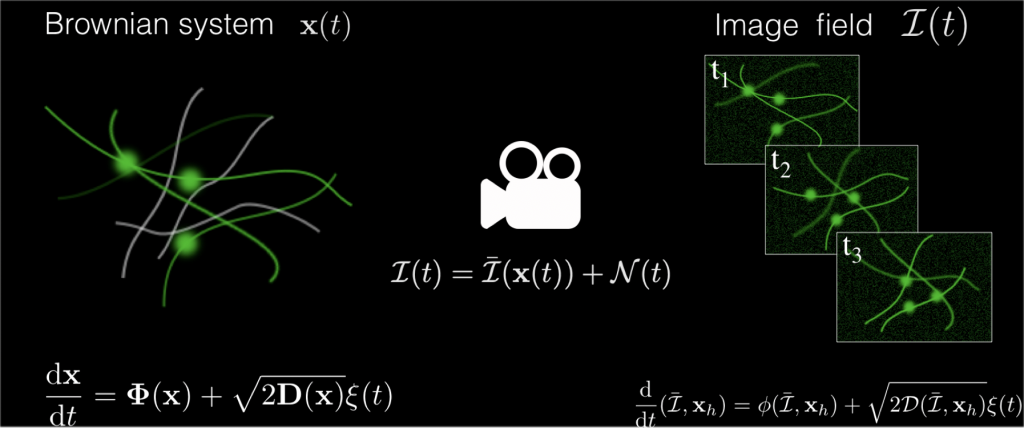
Non-Equilibrium Soft Biological Assemblies
Living systems, such as cells, operate far from thermodynamic equilibrium. They constantly dissipate energy to perform tasks essential to life. This non-equilibrium nature gives rise to the diversity of life phenomena, at the same time making a theoretical description challenging. One of the challenges is measuring the “distance from equilibrium”, often quantified with the entropy production rate, or equivalently the time-irreversibility of the dynamics.

Can you tell how far a system is out of equilibrium just by looking? In our group we study how various measures of time-irreversibility – accessible in a non-invasive way – encode features of the active driving at work and how they manifest on different spatial scales. In particular, we found that in the context of driven viscoelastic gels such measures generically follow scaling laws as a function of distance. The exponents of these scaling laws and transitions between different scaling regimes can be connected to the properties of the active units that drive the system internally. This work thus provides a conceptual connection between the physical properties of the internal active driving in a soft assembly and experimentally measurable quantities at large scales, such as phase space currents, cycling frequencies, and the entropy production rate.

In a related project we developed a method for analyzing raw time-lapse microscopy data, which we refer to as “Brownian Movies”. The key idea is to consider time trajectory of pixel intensities of the experimental images. We start the analysis with a novel dimensionality reduction method, Dissipative Component Analysis, which preserves the most irreversible components of the dynamics. In the next step we use the Stochastic Force Inference framework to learn the deterministic and stochastic part of the dynamics, and estimate the entropy production rate in the system.
Further reading:
Learning the Non-EquilibriumDynamics of Brownian Movies
Federico S. Gnesotto, Grzegorz Gradziuk, Pierre Ronceray, Chase P. Broedersz
Nature Communications 11, 5378 (2020) [arXiv:2001.08642]
Inferring the Dynamics of Underdamped Stochastic Systems
David B. Brückner, Pierre Ronceray, Chase P. Broedersz
Physical Review Letters 125, 058103 (2020), featured as Editors’ suggestion [arXiv:2002.06680]
Broken detailed balance and non-equilibrium dynamics in living systems
Federico S. Gnesotto, Federica Mura, Jannes Gladrow, Chase P. Broedersz
Rep. Prog. Phys. 81, 6 (2018) [arXiv:1710.03456]
Mesoscopic non-equilibrium measures can reveal intrinsic features of the active driving
Federica Mura, Grzegorz Gradziuk, Chase P. Broedersz
Soft Matter 15, 8067-8076 (2019) [arXiv:1905.13663]
Non-equilibrium scaling behaviour in driven soft biological assemblies
Federica Mura, Grzegorz Gradziuk, Chase P. Broedersz
Phys. Rev. Lett. 121 (3), 038002 (2018) [arXiv:1803.02797]
Broken Detailed Balance of Filament Dynamics in Active Networks
Jannes Gladrow, Nikta Fakhri, Fred C. MacKintosh, Christoph F. Schmidt, Chase P. Broedersz
Phys. Rev. Lett. 116 (24), 248301 (2016) [arXiv:1603.04783]
Broken detailed balance at the mesoscale in active biological systems
Christopher Battle*, Chase P. Broedersz*, Nikta Fakhri*, Veikko F. Geyer, Jonathon Howard, Christoph F. Schmidt, Fred C. MacKintosh
Science 352, 604-607 (2016)